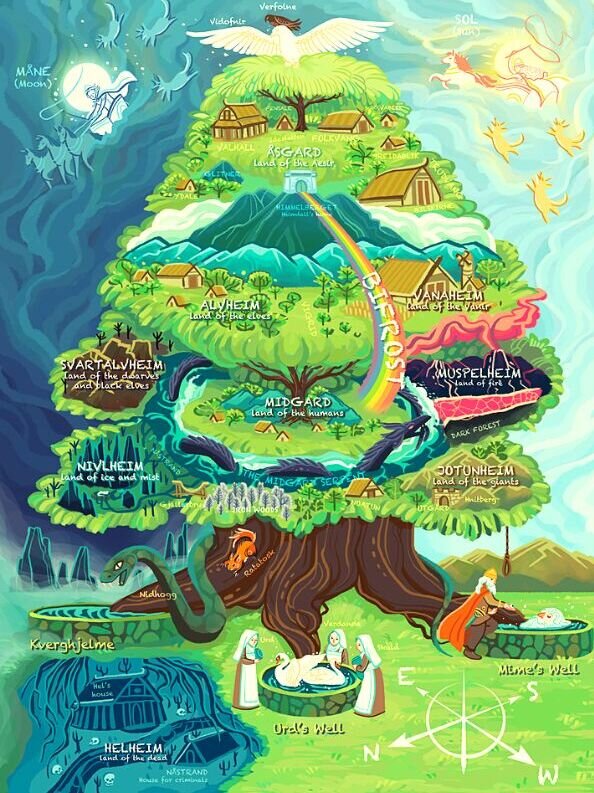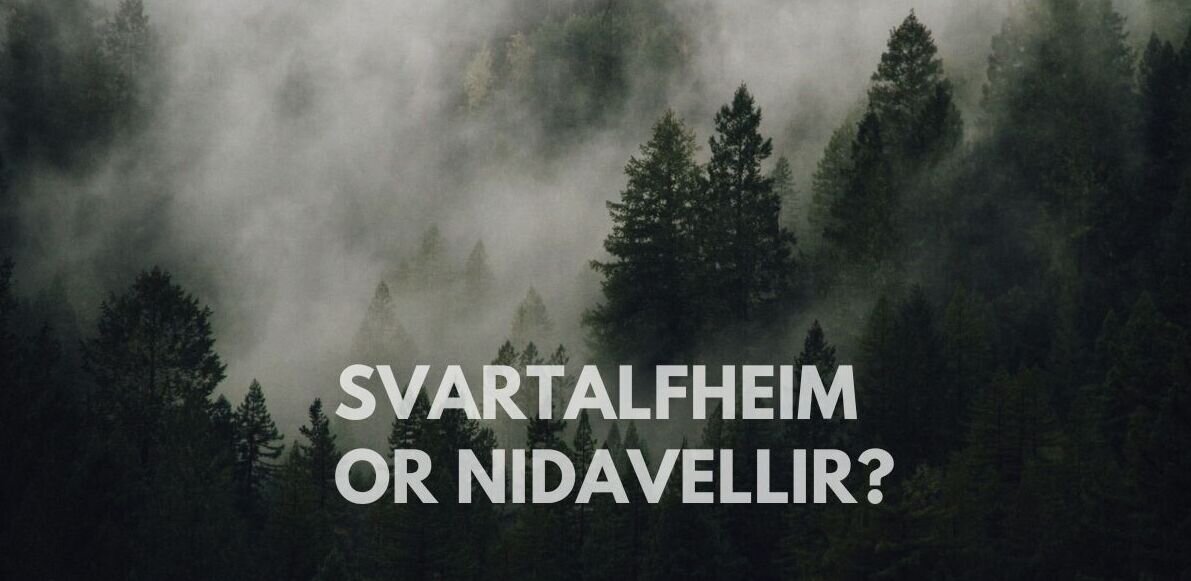Nidavellir (Niðavellir), also called Myrkheim (“Land of Darkness”), is the home of the dwarves in Norse cosmology. Svartalfheim (Svartálfheimr) also appears in some texts as the land of the dwarves, although its translation is “Land of the black elves.” It is possible, therefore, that Nidavellir and Svartalfheim are the same place.
The Prose Edda mentions Svartalfheim on two occasions – they both say it is where dwarves can be found.
Nidavellir and Svartalfheim Etymology
Nidavellir is also spelled Niðavellir, Nidavollum, and Niðavöllum. It means “Dark fields.”
Svartalfheim is also spelled Svartálfheimr. It means “Land of the black elves.” It is also spelt “Svartálfaheimr.“
The Position of Svartalheim and Nidavellir in Norse Cosmology
There is some confusion about the positions and populations of some realms within Norse cosmology. For example, the placement of Vanaheim, the land of the Vanir, can vary depending on which map you use.
However, the most common positions of the nine worlds of Norse are as follows:
Asgard, home of the Æsir led by Odin and Thor, always lies in the highest and central section of the world tree or Yggdrasil. Vanaheim and Alfheim usually flank it. Directly below Asgard lies Midgard. The tree trunk usually connects the two places, so the Bifrost or rainbow bridge can join them.
Further down, we have Jotunheim (land of the ice giants) and Muspelheim (land of fire giants and the god Surtr). Niflheim (land of snow and ice) is sometimes combined with or separate from Hel (or Helheim – the land of the dead), although some maps show one or the other!
Nidavellir (land of dwarves) also requires a little explanation. Nidavellir is often called Svartalfheim (home of the black elves or Svartálfar). However, some maps separate Nidavellir from Svartalfheim and exclude Niflheim or Hel completely.

Svartalheim Vs. Nidavellir in Old Norse Literature
The Poetic Edda
Völuspá
“Niðavöllum” is the site of the golden hall of Sindri’s family, according to this excerpt:
Stóð fyr norðan
á Niðavöllum
salr ór gulli
Sindra ættar;Stood before the north
Nidavollum – Pantheon Org
on Nidavollum
a hall of gold,
for Sindri’s kin;
Sindri was an alias for Eitri, one of the best-known dwarves in Norse mythology.
According to Skáldskaparmál, the mischief god Loki came into possession of Odin’s spear Gungnir (made by the dwarf mastercraftsmen, The Sons of Ivaldi), Freyr’s ship Skidbladnir, and a handcrafted replica lock of Sif’s hair. He wagered his own head with Eitri’s brother Brokkr that Eitri could not match the craftsmanship of these items.
Eitri stoked the fire while his brother worked the bellows. Loki turned into a fly and began biting Brokkr, trying to stop him from keeping the furnace hot. However, Eitri won the bet by creating the golden boar Gullinbursti, the gold ring Draupnir, and Thor’s hammer, Mjölnir.
The Prose Edda
Svartalheim appears twice in the Prose Edda. Both times it describes places where dwarves (“dverga” and “dvergs”) are living with no mention of elves. Further evidence that Svartalheim might be the same as Nidavellir.
Gylfaginning
The first time is in chapter 34 of Gylfaginning:
Eptir þat óttuðusk æsirnir at þeir mundu
eigi fá bundit úlfinn.
Þá sendi Allföðr þann er Skírnir er nefndr,
sendimaðr Freys,
ofan í Svartálfaheim til dverga nökkurra
ok lét gera fjötur þann er Gleifnir heitir.Then Allfather sent him who is called Skírnir,
Gylfaginning – Germanic Mythology
Freyr’s messenger,
down into the region of the Black Elves,
to certain dwarves,
and caused to be made the fetter named Gleipnir.
Skáldskaparmál
It is referenced again in chapter 39 of Skáldskaparmál
fiá sendi Óðinn Loka í Svartálfaheim
ok kom hann til dvergs fless er heitir AndvariThereupon Odin sent Loki into the Land of the Black Elves,
An Excerpt from Skáldskaparmál – Missouri State Edu
and he came to the dwarf who is called Andvari,
who was as a fish in the water.
Are Elves and Dwarves The Same In Old Norse Mythology?
Dwarves were master blacksmiths, miners, and sages in Old Viking mythology and legend. They worked their forges deep inside mountains in the realm of Nidavellir, were short, sturdy, and had long beards. Exposure to direct sunlight would turn them into stone.
Snorri Sturluson, the Icelandic politician, historian, and poet, interpreted the ancient Norse tales and poems as a Christian, writing for a Christian public. The paganism of the source material may well have presented a challenge or been uncomfortable for Sturluson, and he could have altered it to suit his audience.
In chapter 33 of Gylfaginning and 37 of Skáldskaparmál from Sturluson’s compilation and essays, the Prose Edda, he refers to dwarves as “black elves.” However, he is the only person to describe them in this way, so we must be objective in deciding whether this description is accurate.

Dark, Light and Black Elves
Sturluson’s general uses of “dvergar” (dwarves), svartálfar (black elves), “ljósálfar” (light elves), and dökkálfar (dark elves) are also confusing, so it is difficult to say if they are interchangeable.
Svartalfheim means “realm of the black elves.” Using common sense and taking the name of “Svartalfheim” at face value, i.e., Land of the black elves, we might deduce that elves populated this region and dwarves lived in Nidavellir.
Since Sturluson’s Prose Edda is the only source “Svartalfheim” appears in, it may be inaccurate to specify it as one of the nine realms.
So, Are Svartalheim and Nidavellir The Same Place?
It seems likely that Svartalheim and Nidavellir are the same.
The Prose Edda not mentioning elves but talking about dwarves when naming Svartalheim on two occasions would indicate that dwarves live there.
We know dwarves live in Nidavellir from the section in the Völuspá. However, I would add that mentions of Nidavellir in the Eddas are very few, and Wikipedia doesn’t mention it specifically as one of the nine realms, only stating it’s a synonym for Svartalheim.
So, like many Norse myths and sagas, the lack of unambiguous evidence one way or the other means it is open to interpretation.

